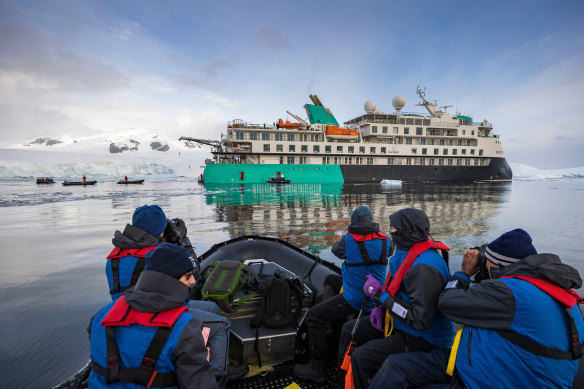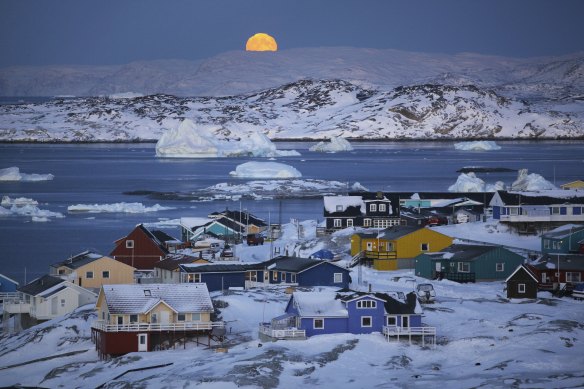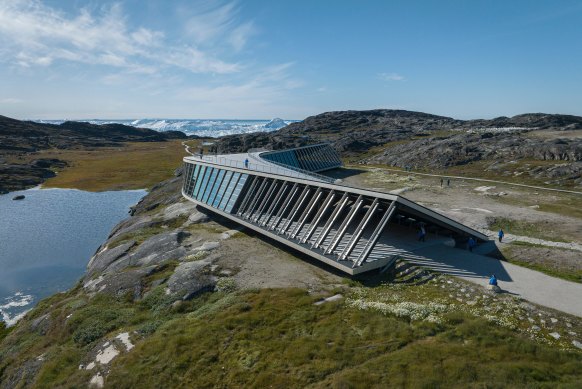A place where the sun never sets (though you still might not see it)
“We’ve got a couple of hours and no real destination,” says voyage historian Nina Gallo as we step onto a stony, treeless shore in Nunavut in northern Canada. She’s talking about our upcoming hike, but she could easily be talking about expedition cruising as a whole.
Gun slung over her shoulder, Nina is leading a group of us on an excursion from the Sylvia Earle, Aurora Expeditions’ newest ship. The gun is for polar bears and, so the jokes go, for passengers who fail to obey the rules.

Sylvia Earle is Aurora Expeditions’ newest ship.
We’re travelling as part of a 17-day itinerary run by Aurora as a partial transit of the North West Passage, starting in Canada and finishing in Western Greenland two weeks later. From a moment before we even started, the original plan was doomed: ice had encased our original embarkation point in Cambridge Bay, meaning we had to fly further north to the unlovely port of Resolution Bay.
When I looked out across the town from the warm comfort of the ship, it seemed resolve would be at least one of the qualities I’d need to live there: rain came in sideways, while a scrapyard formed the backdrop to a glaucous gull pecking at the corpse of a beheaded beluga.
Now, the following day, the hike in the sun feels almost miraculous by comparison, with light catching Arctic plants beneath our feet. Tufted saxifrage, Arctic fireweed, Labrador tea, moss campion, mountain aven…
The expedition team makes the excellent decision to hide out in Maxwell Bay while an angry weather system blows itself hoarse in the Lancaster Sound to the south. Below us, sun glints off the odd-looking X-shaped bow of the Sylvia Earle and, for a while, it seems as though everything on the trip will be smooth.

We’re far enough north in the summer that the sun never sets.Credit: Getty Images
Sylvia Earle herself would likely have told us to expect the unexpected in the Arctic. A legendary marine biologist who has spent decades in the ocean, Earle is now in her 80s, but still made it down to Antarctica in the early months of 2023 for the official launch of the ship that now carries her name.
We are far enough north in the height of summer that the sun never sets, but by the next day the weather is so inclement, we’re faced with a different philosophical question – does the sun ever rise if you never see it?
When we cross back out into the Lancaster Sound, the ship is pushed around by a bully of a wind. Enough people are laid low by this that in the empty lecture theatre, seats spin, as though occupied by gleeful ghosts.
When things calm down, we make excursions on land or on motorised Zodiacs, often deep in fjords sculpted from truly ancient rock. At one point we pass some magnificently marbled gneiss that could be as much as 3.8 billion years old, formed so long ago that it existed before tectonic plates.
“This is the very beginnings of land itself. That’s what we’re travelling through,” says the ship’s geologist, Alex Cowan, sounding awestruck despite or because of his insight.
The weather continues in an unhelpful tone for most of our time in Nunavut, the far-north Canadian province predominantly occupied by Inuit people. Mercifully it relents for just long enough that we are able to make a landing in Arctic Bay, a community of 1000 or so people, most of whom still make their living in fishing and hunting.
Tourism is a nascent business in the North West Passage, as it is for the majority of Inuit communities along its near-mythic route. When we dock in Arctic Bay, we are just the third cruise ship to do so.
A cultural show put on for us is therefore understandably a little chaotic, with people singing across each other, and an animistic dance routine by two brothers that looks absolutely exhausting. At one point during a lull, a dog runs into the community hall, and then trouble really begins.
Outside, I bump into the new science teacher, who has just brought her young family to the town from Saskatchewan in the south of Canada. She intends to stay for three years. “On my first day I saw a narwhal,” she tells me. I almost start to point out how lucky that is, before she explains that it was being eviscerated on the beach at the time. “I said to myself: well, this is definitely the right place.”
Back on board the ship, expedition leader Susan Adie tells me that she rarely gets complaints from people witnessing traditional Inuit hunting, or its bloody aftermath. “I think that stuff can be hard for some people to digest, but I’ve never had anyone say ‘Oh they shouldn’t be doing that’,” says Adie, who has completed 13 transits of the North West Passage. For her, the interactions with the Inuit are vital to the experience.
“I think it should be top of the list,” she continues. “Whenever anyone asks me why the North West Passage is interesting, I say it’s the human history, the evolution and peopling of the Arctic for the last 4000 years. That’s why you should come here.”
To that end, Aurora employs local guides to travel with the ship, introducing and interpreting their remarkable homeland to foreigners. Mariah Erkloo, of Pond Inlet, is taking a break from her studies in British Columbia to travel with guests, giving talks most evenings, or lectures during sea days.
One afternoon, she talks about the Inuit’s changing relationship with the land, highlighting a place whose name translates as Doesn’t Thaw. Due to climate change, that is now a misnomer. “In this case it’s more of a moment in history” says Mariah. “Lots of words relate to the land, but they’re being lost. There’s a famous saying that we have 50 different words for snow… I couldn’t name half of them. Maybe just a handful, but that’s part of a problem, a sign that the relationship to the land is changing.”
Good, or at least clearer, weather awaits us in Greenland, the vast Danish territory which looks like a white wedge between Europe and the Americas on most maps. Arriving across the notorious Baffin Bay, we emerge from sea fog to see sun bathing Arctic meadows.

The Ilulissat Isfjordscenter museum is modern and stylish in a wild and raw landscape.Credit: Alamy
It’s often said that Iceland has no ice and Greenland no green, but neither of these things are true: Greenland is a botanically rich place, with 200 species of mushroom and grasslands so vast they can sustain muskoxen, huge prehistoric ungulates which seem to be waiting impatiently for the next ice age.
We make several stops at established ports along Greenland’s western coast, the highlight of which is Illuisat, a working fishing port and the terminus of a vast glacier. The main differences between this town and one similar in Canada are firstly prosperity and second the number of pastries available in every cafe.
Ultimately, the difference may be distilled down to money and as we reach the face of the icy behemoth that is the Ilulissat Ice Field, we find a fine example. In this sparse land there sits an incongruous museum, the Ilulissat Isfjordscenter, modern and stylish, while so much of the world outside is raw and untamed.
Inside exhibitions detail glaciology and climate science, micro to macro. A short film shows how a snowflake is born, what happens when it collides with others. If that happens a few billion times, a glacier can form. If it happens over eons, entire continents can appear.
Outside, meanwhile, Greenlandic dogs, chained up and waiting for the next snows, are being fed newly dismembered pieces of raw seal. The scenes are related to the same environment, of course, but might as well be beamed in from alien planets.
The writer was a guest of Explore Worldwide
THE DETAILS
Explore Worldwide offers a 17-Day North West Passage Voyage on board Sylvia Earle departing July 20, 2024, or August 3, 2024 from $29,030 a person, including full board on the ship and all excursions. The price is based on two people sharing, excluding international flights.
See exploreworldwide.com.au
Sign up for the Traveller Deals newsletter
Get exclusive travel deals delivered straight to your inbox. Sign up now.